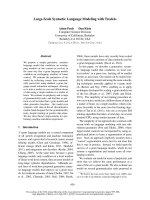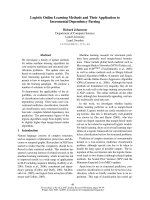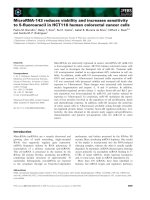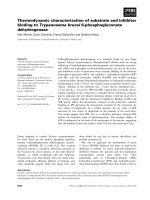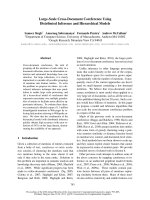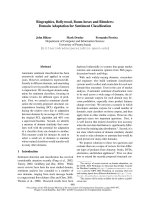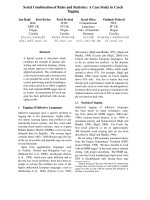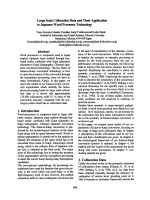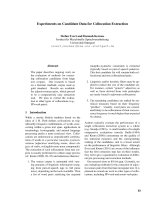Báo cáo khoa học: "Large Scale Collocation Data and Their Application to Japanese Word Processor Technology" potx
Bạn đang xem bản rút gọn của tài liệu. Xem và tải ngay bản đầy đủ của tài liệu tại đây (458.36 KB, 5 trang )
Large Scale Collocation Data and Their Application
to Japanese Word Processor Technology
Yasuo Koymna, Masako Yasutake, Kenji Yoshimura and Kosho Shudo
Institute for Informalion and Conlrol Systmas, Fukuoka University
N~ Fukuoka, 814-0180 Japan
koymm@aisott co.jp, fukuoka-u.ac.jp, ac.jp,
fukuoka-u.ac.jp
abstract
Word processors or computers used in Japan
employ Japanese input method through key-
board stroke combined with Kana (phonetic)
character to Kanji (ideographic, Chinese) char-
acter conversion technology. The key factor of
Kana-to-Kanji conversion technology is how
to raise the accuracy of the conversion through
the homophone processing, since we have so
many homophonic Kanjis. In this paper, we
report the results of our Kana-to-Kanji conver-
sion experiments which embody the homo-
phone processing based on large scale colloca-
tion data. It is shown that approximately
135,000 collocations yield 9.1% raise of the
conversion accuracy compared with the pro-
totype system which has no collocation data.
1. Introduction
Word processors or computers used in Japan ordi-
narily employ Japanese input method through key-
board stroke combined ~ with Kana (phonetic) to
Kanji (ideographic, Chinese) character conversion
technology. The Kana-to-Kanji conversion is per-
formed by the morphological analysis on the input
Kana siring with no space between words. Word- or
phrase-segmentation is carried out by the analysis to
identify the substring of the input which has to be
converted from Kana to Kanji. Kana-Kanji mixed
string, which is the ordinary form of Japanese writ-
ten text, is obtained as the final result. The major
issue of this technology lies in raising the accuracy
of the segmentation and the homophone processing
to select the correct Kanji among many homophonic
candidates.
The conventional methodology for processing
ho-
mophones
have used the function that gives the pri-
ority to the word which was used lastly or to the
high frequency word. In fact, however, this method
sometimes tends to cause inadequate conversion due
to the lack of consideration of the semantic consis-
tency of the word concurrence. While it is difficult
to employ the syntactic or semantic processing in
earnest for the word processor from the cost vs.
performance viewpoints, for example, the following
trials to improve the conversion accuracy have been
reported: Employing the case-frame to check the
semantic consistency of combination of words
[Oshima, Y. et al., 1986]. Employing the neural net-
work to describe the consistency of the concurrence
of words [Kobayashi, T. et al.,1992], Making a con-
currence dictionary for the specific topic or field,
and giving the priority to the word which is in the
dictionary when the topic is identified [Yamamoto,
K. et al., 1992]. In any of these studies, however,
many problems are left unsolved in realizing its
practical system.
Besides these semantic or quasi-semantic gadgets,
we think it much more practical and effective to use
surface level resources, namely, to use extensively
the collocation. But how many collocations contrib-
ute to the accuracy of Kana-to-Kanji conversion is
not known yet.
In this paper, we present some results of our ex-
periments of Kana-to-Kanji conversion, focusing on
the usage of large scale collocation data. In chapter
2, descriptions of the collocations used in our sys-
tem and their classification are given. In chapter 3,
the technological framework of our Kana-to-Kanji
conversion systems is outlined. In chapter 4, the
method and the results of the experiments are given
along with some discussions. In chapter 5, con-
eluding remarks are given.
2. Collocation Data
Unlike the recent works on the automatic extraction
of collocations from corpus [Church, K. W, et al,
1990, Ikehara, S. et al, 1996, etc.], our data have
been collected manually through the intensive in-
vestigation of various texts, spending years on it.
This is because no stochastic framework assures the
694
accuracy of the extraction, namely the necessity and
sufficiency of the data set. The collocations which
are used in our Kana-to-Kanji conversion system
consist of two kinds: (1) idiomatic expressions,
whose meanings seem to be difficult to compose
from the typical meaning of the individual compo-
nent words [Shudo, K. et al., 1988]. (2) stereotypical
expressions in which the concurrence of component
words is seen in the texts with high frequency. The
collocations are also classified into two classes by a
grammatical criterion: one is a class of functional
collocations, which work as functional words such
as particles (postpositionals) or auxiliary verbs, the
other is a class of conceptual collocations which
work as nouns, verbs, adjectives, adverbs, etc. The
latter is further classified into two kinds: uninter-
ruptible collocations, whose concurrence relation-
ship of words are so strong that they can be dealt
with as single words, and interruptible collocations,
which are occasionally used separately.
In the following, the parenthesized number is the
number of expressions adopted in the system.
2.1 Functional Collocations (2,174)
We call expressions which work like a particle rela-
tional collocation and expressions which work like
an auxiliary verb at the end of the predicate auxili-
ary predicative collocation [Shudo, K. et al., 1980].
relational collocations (760)
ex. [ 7./') t, x-C
ni/tuae
(about)
auxiliary predicative collocations (1,414)
naKereoa/naranai
(must)
2.2 Uninterruptible Conceptual Col-
locations (54,290)
four-Kanji-compound (2,231)
ex. ~ ZJlYg.
gaaeninsut
(every miller draws water to his own mill)
adverb + particle type (3,089)
ex ~t:,5,tz.&
• atafutat'o'(da
sconcertedly)
adverb + suru type (1,043)
< <-¢
eX'agt~u<se~cusuru toil and moil)
noun type (21,128)
ex. ~09/~3,
akano/tanin
(perfect stranger)
verb type (13,225)
ex. ~'9 ~J ~'~/~
1-o
otsuriga/~-ru . .
(be enough to make the change)
adjective type (2,394)
ex ]t~ L t,~
• uraganashii
(mournful)
adjective verb type (397)
ex ~t~J~
"goldge-n/naname
(in a bad mood)
adverb and other type (8,185)
ex ~ 17 /,~'C
• meni/miete
(remarkably)
proverb type (2,598)
ex
~ I, ~'C I~I~J ~.I~ ~.
• otteha/koni/shitagae
(when old, obey your children)
2.3 Interruptible Conceptual Colloca-
tions (78,251)
noun type (7,627)
ex. ~$(7)/tttt,
akugyouno/mukui
(fruit of an evil deed)
verb type (64,087)
ex. ~,~. tt:~/~ I 7b~.~
usnlrogamlwo/nlKareru
(feel as if one's heart were left behind)
adjective type (3,617)
ex ~Tb~/:~-~ t,~
"taittbgcr~ool~i
( act in a lordly manner)
adjective verb type (2,018)
ex. tt~Tb~/±
yakushaga/ue (be
more able)
others (902)
ex ~lz/~li'J'~
• atoni/~il~nu
(can not give up)
3. Kana-to-Kanji Conversion Systems
We developed four different Kana-to-Kanji conver-
sion systems, phasing in the collocation data de-
scribed in 2. The technological framework of the
system is based on extended bunsetsu (e-
bunsetsu) model [Shndo, K. et al., 1980] for the
unit of the segmentation of the input Kana string,
and on minimum cost method [Yoshimura, K. et
al., 1987] combined with Viterbi's algorithm
[Viterbi, A,, J., 1967] for the reduction of the ambi-
guity of the segmentation.
A bnn.~etsu is the basic postpositional or predicative
695
phrase which composes Japanese sentences, and an
e-bunsetsu,
which is a natural extension of the bun-
setsu, is defined roughly as follows:
<e-bunsetsu>::= <prefix>* <conceptual word l
uninterruptible conceptual collocation>
<suffix>* <functional word l
functional collocation>*
The e-bunsetsu which includes no collocation is the
bunsetsu. More refmed rules are used in the actual
segmentation process. The interruptible conceptual
collocation is not treated as a single unit but as a
string ofbunsetsus in the segmentation process.
Each collocation in the dictionary which is com-
posed of multiple number of bunsetsus is marked
with the boundary between bunsetsus. The system
first tries to segment the input Kana string into e-
bunsetsus. Every possible segmentation is evaluated
by its cost. A segmentation which is assigned the
least cost is chosen as the solution.
The boundary between e-bunsetsus in examples in
this paper is denoted by "/".
ex. two results of e-bunsetsu-segmentation:
, hitoh.a/kigqkikunikositagotol, taarimasen
(there is nothing like being watchful)
hitohdv'Mga/Idkimi/ko3itcv;kotoha/arimasen
In the above examples, JKT~/~I] <
kiga/kiku:
is
uninterruptible conceptual collocation and IS-/il~ I.,
Lx/II~|~/~ ~) ~'t~ A~ ni/kosita/kotoha/arimasen:
is
a functional collocation. In the first example, these
collocations are dealt with a single words. The
second example shows the conventional bunsetsu-
segmentation.
The cost for the segmentation candidate is the sum
of three partial costs: b-cost, c-cost and d-cost
shown below.
(1)a segment cost is assigned to each segment. Sum
of segment costs of all segments is the basic cost
(b-cost) of a segmentation candidate. By this, the
collocation tends to have priority over the ordi-
nary word. The standard and initial value of each
segment cost is 2, and it is increased by 1 for each
occurrence of the prefix, su_Wnx, etc. in the seg-
ment.
(2)a concatenation cost (c-cost) is assigned to speci-
fic e-bunsetsu boundaries to revise the b-cost.
The concatenation, such as adnominal-noun, ad-
verb-verb, noun-noun, etc. is paid a bonus ,
namely a negative cost, -1.
(3)a dependency cost (d-cost), which has a negative
value, is assigned to the strong dependency rela-
tionship between conceptual words in the candi-
date, representing the consistency of concurrence
of conceptual words. By this, the segmentation
containing the interrupted conceptual collocation
tends to have priority. The value of a d-cost varies
from -3 to -1, depending on the strength of the
concurrence. The interruptible conceptual collo-
cation is given the biggest bonus i.e 3.
The reduction of the homophonic ambiguity, which
limits Kanji candidates, is carried out in the course
of the segmentation and its evaluation by the cost.
3.1 Prototype System A
We first developed a prototype Kana-to-Kanji con-
version system which we call System A, revising
Kana-to-Kanji conversion software on the market,
WXG Ver2.05 for PC.
System A has no collocation data but conventional
lexical resources, namely functional words (1,010)
and conceptual words (131,66 I).
3.2 System B, C and D
We reinforced System A to obtain System B, C and
D by phasing in the following collocational re-
sources. System B is System A equipped addition-
ally with functional collocations (2,174) and unin-
terruptible conceptual collocations except for four-
Kanji-compound and proverb type collocations
(49,461). System C is System B equipped addition-
ally with four-Kanji-compound (2,231) and proverb
type collocations (2,598). Further, System D is
System C equipped additionally with interruptible
conceptual collocations (78,251).
4. Experiments
4.1 Text Data for Evaluation
Prior to the experiments of Kana-to-Kanji conver-
sion, we prepared a large volume of text data by
hand which is formally a set of triples whose first
component a is a Kana string (a sentence) with no
space, The second component b is the correct seg-
mentation result of a, indicating each boundary
between bunsetsus with "/" or ".". '7" and
means obligatory and optional boundary, respec-
tively. The third component c is the correct conver-
sion result of a, which is a Kana-Kanji mixed string.
ex. { a: {S-;[9[s-[~7b~l,~-Ct,~To
niwanibaragasaiteiru
696
(roses are in bloom in a garden)
b:
IZab)[7-/[~?~/~ [,~.(,~70
niwani/baraga/saite, iru
c:
I~I~.I#~#J~II~I,~T I,x,'~ }
The introduction of the optional boundary assures
the flexible evaluation. For example, each ofl~lA
"C/t,~ saite/iru (be in
bloom) and I~I,~'CIA~
saiteiru
is accepted as a correct result. The data fde
is divided into two sub-files, fl and 12, depending
on the number of bunsetsus in the Kana string a. fl
has 10,733 triples, whose a has less than five
bunsetsus and t2 has 12,192 triples, whose a has
more than four bunsetsus.
4.2 Method of Evaluation
Each a in the text data is fed to the conversion sys-
tem. The system outputs two forms of the least cost
result: b', Kana string segmented to bunsetsus by
"/", and c', Kana-Kanji mixed string corresponding
to b and c of the correct data, respectively. Each of
the following three cases is counted for the evalua-
tion.
SS (Segmentation Success): b
TM
b
CS (Complete Success): b
TM
b and ¢'= ¢
TS (Tolerative Success): b'= b and ¢'~ ¢
There are many kinds of notational fluctuation in
Japanese. For example, the conjugational suffix of
some kind of Japanese verb is not always necessi-
tated, therefore,~l,,I I'{'f,~fi I'I'Y and ~.1: are all
acceptable results for input ~ L)~ I~
uriage
(sales).
Besides, a single word has sometimes more than
one Kanji notations, e.g. "~g hama (beach) and ;~
hama
(beach) are both acceptable, and so on. c'- ¢
in the case of TS means that e' coincides with ¢
completely or excepting the part which is hetero-
morphic in the above sense. For this, each of our
conversion system has a dictionary which contains
approximately 35,000 fluctuated notations of con-
ceptual words.
4.3 Results of Experiments
Results of the experiments are given in Table 1 and
Table 2 for input file fl and 12, respectively.
Comparing the statistics of system A with D, we can
conclude that the introduction of approximately
135,000 collocation data causes 8.1% and 10.5 %
raise of CS and TS rate, respectively, in case of re-
latively short input strings (fl). The raise of SS rate
for t"1 is 2.7%. In case of the longer input strings (t2)
whose average number of bunsetsus is approxi-
mately 12.6, the raise ofCS, TS and SS rate is 2.4 %,
5.2 % and 5.7 %, respectively. As a consequence,
the raise ofCS, TS and SS rate is 6.2 %, 9.1% and
3.8 % on the average, respectively.
SS(Segmentation Success)
CS(Complete Success)
TS(Tolerative Success)
S~,stem A S)rstem B S~/stern C
9,656(90.0°,6) 9,912(92.4%) 9,927(92.5%)
5,085(47.4%) 5,638(52.5%) 5,677(52.9°,6)
6,226(58.0°,6) 6,971(64.9°,6) 7,024(65.4°,6)
Table 1 :Result of the experiments for 10,733 short input strings d~a, fl.
(average number of Kana characters per input is 13.7)
S~¢stem D
9,954(92.7%)
5,953(55.5%)
7,355(68.5%)
SS
CS
TS
S~tma A S),~ B S),stma C
8,345(68.4%) 8,978(73.6%) 8,988(73.7%)
2,422(19.9°,6) 2,660(21.8%) 2~673(21.90"6)
3,965(32.5%) 4,555(37.4%) 4,568(37.5%)
Table 2: Result ofthe expea-huents for 12,192 long input strings dam, t2.
(average number of Kana characters per input is 42.7)
S~¢stem D
9,037(74.1%)
2,717(22.3%)
4,601(37.7%)
S~-tem D' WXG
SS 9,949(92.7%) 9,804(91.3%)
CS 6,180(57.6%) 5,877(54.8°,6)
TS 7,646(71.2%) 7,290(67.9°,6)
Table 3 :CompmJson of system D' with WXG for fl.
S mD'
SS 8,928(73.2%) 8,815(72.3%)
CS 2,738(22.5%) 2,694(22.1%)
TS 4,649(38.1%) 4,543(37.3%)
Table 4: Comparison of system D' with WXG for 12.
697
4.4 Comparison with a Software on the
Market
We compared System D with a Kana-to-Kanji conver-
sion soRware for PC on the market, WXG Ver2.05 under
the same condition except for the anaount of installed
collocation dam For this, system D was reinforced and
renmned D', by equipping with WXG's 10,000 items of
word dependency description. Both systems were dis-
abled for the learning
functiom
WXG has approximately
60,000 collocations (3,000 unintcrmptible and 57,000
interruptible collocations), whereas Syst~nn D' has ap-
proximately 135,000 collocations. The statistical results
are givm in Table 3
and
Table 4 for the corpus fl and t2,
respectively.
The tables show that the raise of CS, TS and SS rme,
which was oblained by System D' is 2.5 %, 4.5 % and
3.9 % on the average, respectively. No fialher compari-
son with the conanercial products has been done, since
we judge the perfommnce ofWXG Ver.2.05 to be aver-
age among them.
4.5 Discussions
Table 1 '~ 4 show that the longer input the system is
given, the more difficult for the system to make the cor-
rect solution and the difference between accuracy rate of
WXG and system D' is less for f2 than for fl. Further
investigation clarified that the error of System D is
mainly caused by missing words or expressions in the
machine dictionmy. Specifically, it was clmified that the
dictionary does not have the sufficient number of Kata-
Kzna words and people's names. In Mdition, the number
of fluctualional
variants installed in
the dictionary men-
fioned in 4.2 turned out to be inst~cient. These problems
should be rmaedied in future.
5. Concluding Remarks
In this p,%~r, the effectiveness of the large scale colloca-
tion data for the improvement of the conversion accuracy
of Kana-to-Kanji conversion process used in Japmese
word processors was chrified, by relatively large scale
experiments.
The extensive collection of the collocations has been
c,m'fied out manually these ten years by the authors in
order to realize not only high precision word processor
but also more general Japanese language ~ in
future. A lot of resources, school texttx3oks, newspapers,
novels, journals, dictionaries, etc. have been investigated
by workers for the collection. The candidates for the col-
location have been judged one after another by them.
Among collocations described in this paper, the idiomatic
expressions are quite burdensome in the developmera of
NLP, since thW do not follow the principle of composi-
lionality of the memaing Generally speaking the more
extensive collocational d__~___ it deals with, the less the
"rule syst~n" of the rule based NLP system is burdened.
This means the great importance of the enrichment of
collocalional data Whereas it is inevitable that the ~oi-
awiness lies in the human judgment and selection of
collocations, we believe that our collocation rl~ is far
more refined than the automalicany extracted one from
corpora which has been recently reported [Church, K. W.
etal, 1990, Ikeham, S. etal, 1996, etc.].
We believe that the approach descrlqxxi here is important
for the evolution of NLP product in general as well.
References
Shudo, K. et ~, 1980. Morphological Aspect of Japanese
Language Processing, in Proc. of 8 th Int~a,-~Con£ on
Comps_ __a~__'onal Linguistics(COLING80)
Oshima, Y. et al., 1986. A Disarnbiguation Method in
Kana-to-Kanji Conversion Using Case Frame Gram-
rn,'~, in Trans. oflPSJ, 27-7. (in Japanese)
Kobayashi, T. et al. ,1986. RealiTation of Kana-to-Kanji
Conversion Using Neural Networks. in Toshiba
Review, 47-11. (in J~anese)
Yoshimura, K. et a1.,1987. Morphological Analysis of Ja-
panese S~tences using the Least Cost Metho~ in IPSJ
SIG NL.60. (in J nese)
Shudo, K. et al. ,1988. On the Idiomatic Expressions in
Japanese Language. in IPSJ SIG NL-66. (in Japanese)
Church, K.W. et al, 1990. Word Association Norms,
Mutual Information, and Lexicography. in Comput-
ational Linguistics, 16.
Yamamoto, K. et al. ,1992. Kana-to-Kanji Conversion
Using Co-occtm~ce Groups. in Proc. of44th Con£ of
IPSJ. (in Japanese)
Ikehara, S. et al., 1996. A Statistical Method for
Extracting Uninterrupted and Interrupted Collocations
l~om Very Large Corpora_ in Proc. of 16th Internat.
Conf. on Computational Linguistics (COLING 96)
Viterbi,A.,J., 1967,F_gor Bounds for Convolutional Codes
and an Asymptotically Optimal Decoding Algorithm.
in ~ Trans. on Infommfion Theory 13.
698
